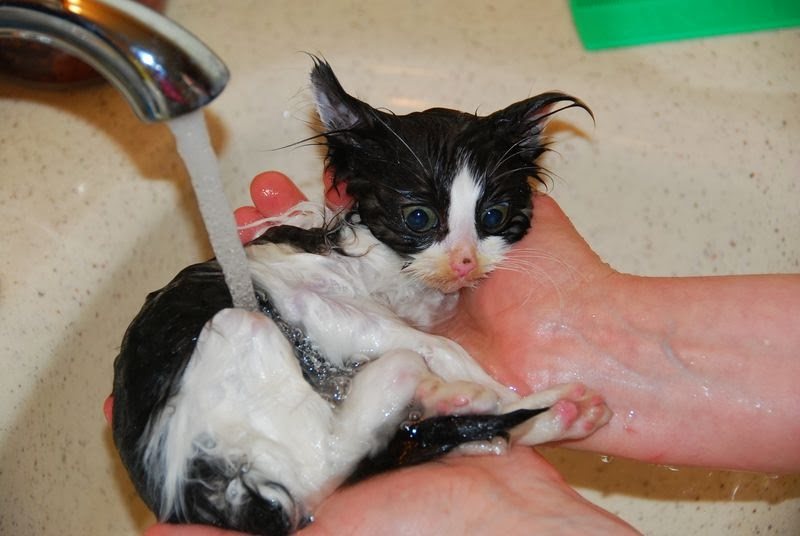When to Vaccinate, Deworm, Spay, Neuter, Blood-Type, and Microchip Your Kitten
You have just become the new proud parent of the wonderful furry creature known as "a kitten".
Let me make this perfectly clear, do not do what your instincts might be telling you to do. This is not the first step to kitten parenting: |
Approximately 7-9 weeks of age:
* FeLV and FIV test
* first FVRCP vaccination
* first deworming
* blood typing
* nail trimming demonstration
* tooth brushing demonstration
Approximately 10-12 weeks of age:
* second FVRCP vaccination
* second deworming
Approximately 13-16 weeks of age:
* third and final FVRCP vaccination
* rabies vaccination
* fecal exam
24 weeks of age:
* spay/neuter
* microchipping
The first thing to do is contact a local veterinarian's office (If you're in New York City -> Manhattan Cat Specialists) and schedule a physical exam --this is your new kitty's first "check-up."
Tests are administered for FeLV and FIV, to make certain the kitten is starting out its life without either of these two deleterious viruses.
Assuming the kitten is around 7 weeks old, your kitten is given the first FVRCP vaccine, and then deworm. A fecal sample should be evaluated at this time to check for parasites that the common dewormers would not treat, such as coccidia and giardia.
Three weeks later, at age 10 weeks, the second FVRCP and another deworming. Three weeks after that, at age 13 weeks, a third FVRCP. Three weeks later, at 16 weeks, the final FVRCP and the rabies.
At around 24 weeks of age, spay or neuter. This would be a good time to microchip, although microchipping can be done at any time.
Pediatric vaccination protocol
Kittens are the main target population for vaccination, because they are more susceptible to infection than adult cats, and they tend to develop more severe disease compared to adults. The currently recommended vaccination protocol is as follows:
The kitten vaccination series should begin at 6 to 8 weeks of age. Kittens should initially receive the FVRCP (panleukopenia, herpesvirus, and calicivirus) vaccine, with additional boosters given every 3 – 4 weeks until 16 weeks of age. Kittens older than 12 weeks of age should receive an initial FVRCP vaccine, followed by one additional FVRCP booster 3 – 4 weeks later.
Kittens should receive a rabies vaccine at 12 – 16 weeks of age.
The feline leukemia virus (FeLV) vaccine is a non-core vaccine (i.e. optional, depending on the cat’s lifestyle) in adult cats, however, all kittens should be vaccinated against FeLV, because the lifestyles of kittens often change after adoption, increasing their risk for FeLV exposure. A booster vaccine should be given one year later in cats that remain at risk for exposure to FeLV.
One year after the last vaccination, an FVRCP vaccine and a rabies vaccine should again be administered.
Vaccines against infectious diseases have done much to reduce sickness and death in companion animals, and vaccination is the cornerstone of preventive veterinary medicine. As with any medical procedure or decision, the advantages must be balance against the risks, and you and your veterinarian should discuss all of the options now available to determine the best vaccine protocol for your cat.
SEE ALSO:
Feline Vaccination Protocol
Why We Vaccinate (Even Indoor) Cats

Comments
Post a Comment